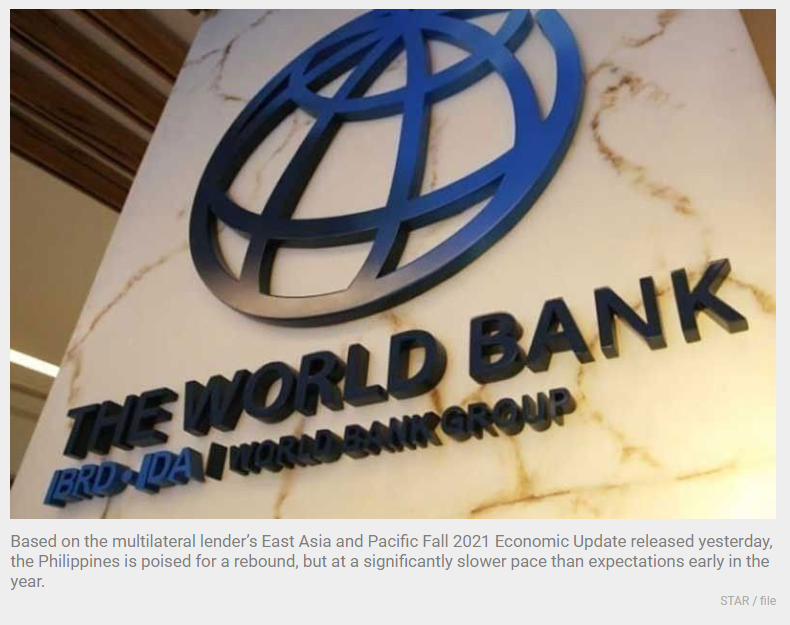World Bank less bullish on Philippine growth prospects
MANILA, Philippines — The World Bank turned less bullish on economic recovery for the Philippines after it further downgraded the country’s growth prospects for the year amid the renewed lockdown due to the Delta variant and the still slow pace of vaccine rollout.
Based on the multilateral lender’s East Asia and Pacific Fall 2021 Economic Update released yesterday, the Philippines is poised for a rebound, but at a significantly slower pace than expectations early in the year.
The Washington-based World Bank said gross domestic product (GDP) for 2021 is now forecast at 4.3 percent, lower than the 4.7 percent projection in June and a huge drop from its 5.5 percent outlook in April.
At the start of 2021, the World Bank even penciled in a 5.9 percent growth.
The World Bank’s forecast now falls within the government’s revised GDP growth target of four to five percent for the whole year. The economy is coming off a 9.6 percent contraction in 2020.
For 2022, the World Bank also slashed its growth forecast to 5.8 percent from 6.3 percent in April.
While most countries in the region will start slowly recovering, the Philippines is expected to be late in the game as pre-pandemic GDP levels will only be achieved by 2023, at the earliest.
It will lag behind the recovery of Cambodia, Mongolia, and Malaysia, which are seen bouncing back to pre-COVID by next year. Indonesia, Vietnam, and China will also rebound faster this year.
In yesterday’s briefing, World Bank East Asia and Pacific chief economist Aaditya Mattoo said the Philippines has suffered enormously because of COVID-19, prompting one of the largest declines in growth forecasts.
“We do see the challenge that this is a country which supplies the world with medical staff and nurses, and it is a particular tragedy that domestically, it has not really succeeded in,” Mattoo said.
“But it’s not just a difficulty of policy, the Philippines remains highly vulnerable to natural disasters, and those are not easy to deal with,” he said.
Unfortunately, the Philippines also continues to struggle in vaccinating its population with availability of COVID-19 jabs remaining an issue due to limited global production capacity and the decision to provide booster vaccines in advanced economies.
“It had a problem with vaccine hesitancy, it had not acquired enough vaccine and it had a late entrance into the vaccine market,” Mattoo said.
The World Bank is expecting the Philippines to hit the 60 percent population threshold by the second quarter of 2022, behind the government’s first quarter expectation.
Latest data showed that 19 percent or about 20.3 million Filipinos have been fully vaccinated while those who were given at least one dose reached 25.2 million or some 23.3 percent of the population.
Amid increasing vaccine coverage, Mattoo said it is important to have continued precautionary behavior, stronger testing, and a better health system.
“We must not think of vaccines as a miracle. Vaccines are one weapon in our arsenal,” Mattoo said.
“Learn to live with the disease, it will be here in the foreseeable future. So, strengthening the health system and learning to provide the care that is needed when it is needed are going to be really important steps in terms of the economy,” he said.
Further, the World Bank also urged the Philippines to do more to guarantee the rights of foreign investors and to simplify the complex and long negative list of still restricted sectors.
Laws that make the economy less restrictive to foreign investments such as the amendments to the Retail Trade Liberalization Act, the Foreign Investment Act and the Public Service Act, are key.
While remittances are relatively stable, Mattoo emphasized that tourism, which the Philippines is also heavily dependent on, is unlikely to immediately come back.
He added that in manufacturing, the Philippines has remained engaged in global value chains but has not really succeeded as much as it should be. The same can be said on services that have not developed as much.
“The agenda remains on greater fiscal reform, more revenue mobilization that allow the state to invest in the infrastructure that is needed for growth,” Mattoo said.
“As well as strengthening the educational sector, harnessing new technologies to consolidate its strength in the services sector, and also to catalyze further its participation in manufacturing and global value chains,” he said.
In the whole of East Asia and the Pacific, the World Bank said the damage done by the resurgence and persistence of COVID-19 is likely to hurt growth and increase inequality over the longer-term.
It noted that households have suffered, especially poorer ones, which have been more likely to lose income, suffer greater food insecurity, have children not engaged in learning, and make distress sales of scarce assets.
Beyond containing COVID-19, the World Bank said a comprehensive strategy will be needed to boost growth and ensure it is inclusive.
Source: https://www.philstar.com/business/2021/09/29/2130361/world-bank-less-bullish-philippine-growth-prospects


 Thailand
Thailand




